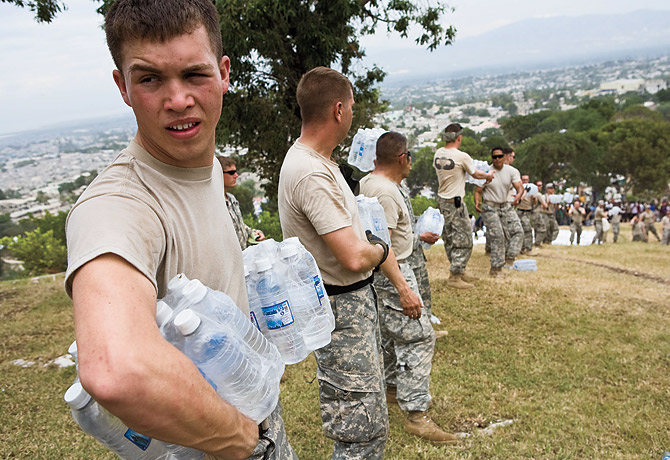
U.S. soldiers deliver water to earthquake survivors in Haiti.
After the quake came the flood. In the wake of the 7.0-magnitude temblor that rocked Haiti on Jan. 12, killing as many as 200,000 people, a deluge of donations poured in from around the world — more than $200 million in the first week. Relief groups have pledged to see that Haitians get as much of that aid as possible, often slashing the administrative costs that can account for up to 35% of a donation.
What happens to that money next depends in part on how it was given. Mobile phones have been a popular way to give — donors texted more than $24 million to the American Red Cross in the first week — but they're not the speediest. The donation generally isn't processed until the giver pays his or her phone bill, which means it can take up to 90 days for the charity to see a penny. (Phone companies have agreed to expedite the process.) Contributions made with a credit card, in most cases, are delivered to aid agencies' coffers immediately.
Once the money arrives in Haiti, choices about how to spend it are made largely by staff on the ground. There are a few reasons for this: With electricity spotty and mobile-phone networks down in the first few days, communication with headquarters has been difficult. And some relief groups have been active in Haiti for decades. Aid workers who were there when the quake struck have suffered alongside those they're helping — UNICEF workers saw their headquarters destroyed, and World Vision personnel are operating out of a parking lot — and also understand local customs and have relationships with local partners. As in disasters past, these workers will share that knowledge with more-recent arrivals in talks brokered by the U.N. among NGOs, the Haitian government and donor countries. The groups face close scrutiny: officials at the Red Cross, for instance — which drew criticism for shoddy planning and poor management of the $2 billion in donations it received after Hurricane Katrina — have said transparency and accountability are top priorities.
In the immediate aftermath of the earthquake, rescuers focused on finding survivors as quickly as possible. Humanitarian operations were mobilized within 24 hours, but it could take up to two weeks to get those efforts up to full speed. Aid groups are already settling into the niches they occupied in past disasters: UNICEF provides clean water and safe spaces for children; the Red Cross leads the charge on emergency medical care; the International Rescue Committee doles out household goods and prevents violence against women. "It's a well-oiled machine," says Edward Brown, World Vision's relief director in the U.S. "We've done this before. We'll have to do it again."